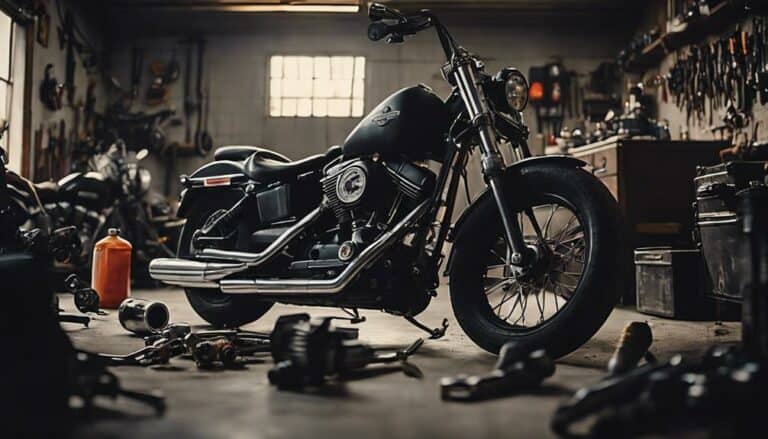Feeling invincible, are you? Owning a Harley-Davidson demands more than just a casual Sunday ride. Wondering how frequently you should service your prized possession to keep it purring like a contented cat?
A well-maintained Harley isn't just about the roar; it's about longevity and safety too. But, before you hit the road, let's break down the essential maintenance intervals that will keep your Harley-Davidson in excellent condition.
Key Takeaways
- Adhere to Harley-Davidson's service intervals for optimal performance and longevity.
- Regular oil changes, especially with synthetic oil, are crucial for engine health.
- Maintain brake system efficiency by monitoring pads and fluid levels.
- Regularly check tire pressure, tread wear, and spokes for safe and stable rides.
Recommended Service Intervals
To guarantee the best performance and longevity of your Harley Davidson, it's essential to adhere to the recommended service intervals provided by Harley-Davidson mechanics. The owner's manual is your go-to guide for maintaining your bike's engine oil at best levels. Harley-Davidson suggests servicing your motorcycle at 1,000 miles, followed by subsequent services every 5,000 miles. These intervals are critical for the proper functioning of your bike.
Major checkpoints at 1,000, 10,000, and 20,000 miles are pivotal for maintenance, making sure that your Harley remains in top condition. Additional checks at 5,000 and 15,000 miles further guarantee the smooth operation of your motorcycle. By following these service intervals diligently, you not only maintain the value of your bike but also ensure its longevity.
Professional Inspection Checklist
When maintaining your Harley Davidson at recommended service intervals, it's imperative to thoroughly inspect key components through a professional checklist to secure peak performance and safety on the road. To make sure your Harley Davidson is in top condition, follow these key inspection points:
- Regular Intervals: Schedule professional inspections at 1,000, 10,000, and 20,000-mile intervals to guarantee all components are functioning at their best.
- Additional Checks: Conduct extra checks at 5,000 and 15,000 miles to make certain your motorcycle's performance remains at its peak.
- Use Synthetic Oil: Utilize synthetic oil during these inspections to maintain engine efficiency and longevity.
Following this checklist meticulously will help identify any issues early on, making sure your Harley Davidson operates smoothly and safely on the road. Professional maintenance is essential for keeping your bike in prime condition, allowing you to enjoy the ride without any worries.
Importance of Oil Changes
For optimal engine performance and longevity on your Harley-Davidson motorcycle, regular oil changes are critical maintenance tasks that shouldn't be overlooked. Keeping up with oil changes at regular intervals is essential to make sure that your engine runs smoothly, prevents wear, and maintains peak performance.
Harley-Davidson recommends changing mineral-based oil every 2,000 miles and synthetic oil every 5,000 miles. Many riders prefer synthetic oil due to its enhanced performance and longevity compared to mineral-based oil. It's also important to replace the oil filter with every oil change to keep the oil clean and maintain optimal engine function.
Depending on your riding habits and maintenance preferences, some riders choose to change their oil every 3,000 to 5,000 miles. By adhering to these recommended intervals and practices, you can make sure your Harley-Davidson motorcycle continues to perform at its best.
Brake System Maintenance
Guarantee peak performance and safety by diligently maintaining your Harley-Davidson's brake system, starting with regular checks on brake pads for wear and tear. To make certain your brake system operates at its best, follow these essential steps:
- Check Brake Pads: Regularly inspect your brake pads for thickness and signs of wearing down. Replace them if they're worn beyond the manufacturer's recommended limit to maintain best braking efficiency.
- Inspect Brake Fluid Reservoirs: Monitor the brake fluid levels in the reservoirs and top them up as needed. Proper fluid levels are critical for the brake system to function effectively and prevent air from entering the lines.
- Perform Road Test: After conducting maintenance or repairs on the brake system, take your Harley Davidson for a road test. Test the brakes at various speeds and intensities to make sure they're responsive and reliable in different situations.
Tire Care and Pressure Checking
Maintain peak performance and safety for your Harley-Davidson by regularly checking tire pressure before every ride. Proper tire pressure is essential for ideal handling and stability. Before each ride, make sure that your tires are inflated to the recommended psi levels specified by the manufacturer. Insufficient tire pressure can lead to poor road grip and affect overall performance.
Regularly inspect your tires for tread wear and cracks that could compromise safety on the road. Worn-out treads reduce traction, especially in wet or slippery conditions. Additionally, checking the tightness of wheel spokes is vital to maintain wheel alignment and stability while riding.
For added safety and performance, consider professional inspections, especially before long rides or trips. Experts can detect potential issues early on, ensuring that your tires are in top condition for a smooth and secure ride. By staying vigilant with tire care and pressure checking, you can enhance your Harley-Davidson's performance and enjoy the freedom of the open road.
Conclusion
You should service your Harley-Davidson at recommended intervals to guarantee peak performance. Neglecting maintenance can lead to costly repairs and safety hazards.
For example, a rider who skipped regular service intervals experienced brake failure while riding, resulting in a serious accident.
Don't let this happen to you – prioritize servicing your Harley-Davidson for a smooth and safe ride every time.

